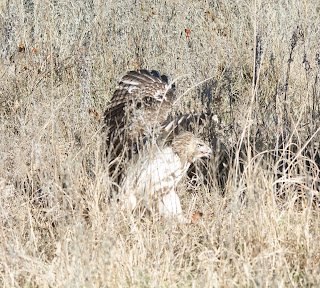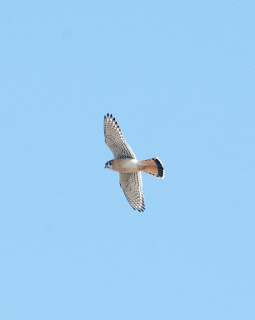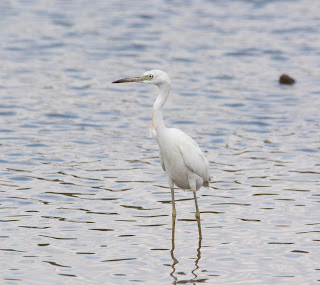Translate
Sunday, December 31, 2017
A Portion of Christmas Bird Count, Northwest Payne County
Yellow-bellied Sapsucker
Barred Owl
Hermit Thrush
Golden-crowned Kinglet
12-30-17
1050-1610/19 F (wind chill 11F)/mostly cloudy with very light snow/NNE-8
This was a most fortuitous day, even though it was extremely cold and very cloudy. When one is a
serious birder, the only thing that matters for Christmas Bird Count is that the barometric pressure be rising. Today, it was.
With this being my first cold day out and about since hand surgery, I was slightly apprehensive, but we were car birding and that literally took the chill out of my apprehension.
When we got to our destination, we encountered a very light snow, which lasted the better part of this trip, which for all intents and purposes, I considered icing on the cake. Serious birders know that certain things are a plus for birding and I knew this was going to be an incredible day. Even though we were the last to sign up for the Audubon Christmas Bird Count, our area was not terribly desirable due to lack of bodies of water, weather conditions improved it. When the barometer rises like it did, things rapidly change for the better.
Our day was excellent, not only for what we saw, but for what happened to make itself visible. These
photos happen to show what I considered good birds for me, because the better part of these, I had been unable to photograph until today. The shot of the Golden-crowned Kinglet isn't the usual quality that I hope for, but this shot took YEARS. The Hermit Thrush doesn't usually make itself visible, so this was the first photo op that it ever gave me. I had only heard it in the past. This adult Yellow-bellied Sapsucker was the first adult that I have been privy to in such prime conditions.
My companions were equally as happy. So when you have something to do when it comes to birding and the weather is not quite to your liking, you'd best get out there, because you could have missed those pictures that you have been trying to obtain for quite some time. I'm glad that I did it.
By the way, my hand did quite well.
Saturday, December 30, 2017
Friday, December 29, 2017
Thursday, December 28, 2017
Wednesday, December 27, 2017
Monday, December 25, 2017
Sunday, December 24, 2017
Saturday, December 23, 2017
Friday, December 22, 2017
Thursday, December 21, 2017
Wednesday, December 20, 2017
Tuesday, December 19, 2017
Monday, December 18, 2017
Sunday, December 17, 2017
Saturday, December 16, 2017
Friday, December 15, 2017
Thursday, December 14, 2017
Lake Thunderbird, Eastland, Texas Falconry, and Lake Hefner
Red-necked Grebe
11-24-17
This was the day that my birding friend called and wanted to do something in way of birds. No matter how I feel, even after six weeks post hand surgery, I said that I wanted to go. We knew about the rare Red-eared Grebe and hoped for a sighting and a photo, if we were lucky. The closest report was at Lake Carl Blackwell, Payne County, but it was not there. We went to the second reporting sight, and there it was, at the local grebe convention. Many birders have seen it, but I never thought that I would be so lucky.
Needless to say, I could not carry my camera, nor could I use my left hand after the hand surgery. I relied on help, so that was the only way that this shot could happen. Thanks to Sylvias Serpentine, who saved my day!
Barred Owl
12-02-17
We were due for another adventure, so The Three Musketeers went to Sequoyah National Wildlife Refuge in Vian, OK, for more action. There was plenty there, but I was not able to do anything yet, other than hit the shutter button and change ISO. At least I got this beautiful Barred Owl. My comrades managed both Ruby- and Red-crowned Kinglets, but they were too fast for me. Thanks for setting up my camera several times, dear friends.
12-07 through 12-10-17
To the hunt, to the hunt, to the hunt! This was the famous Ryan Vance memorial Hunt and what a turnout for the events. Everyone with a raptor came to hunt prey or show their birds at the educational show at the Eastland, TX Museum.
I got myself another trophy or three, which included photos of some gorgeous Harlan's Hawks, which I had never seen before. Believe it or not, the first rabbit kill was done by a dog, not a raptor. To the victor belongs the spoils and did we have a fantastic weekend.
The best part for me was the fact that my doctor cleared me to bring my camera, but I had to follow certain restrictions.
JD and his Red-tailed Hawk
JD's Red-tail solo
Savannah Sparrow
CS's Red-tail at a kill
CS and her Red-tail, who got a rabbit
Wild American Kestrel
Harris's Hawk
Harlan's Hawk #1
Harlan's Hawk #2 (Female)
Harlan's Hawks #2 (on right - female)
and #3 (Male on left)
JD's Red-tail in flight
JD's Red-tail banking
Two Yellow-billed Loons
The last photo was on on return trip after the hunting trip where we observed Yellow-billed Loons on
Lake Hefner in Oklahoma City. What a trip!
Wednesday, December 13, 2017
Tuesday, December 12, 2017
Monday, December 11, 2017
Sunday, December 10, 2017
Thursday, December 7, 2017
Wednesday, December 6, 2017
Tuesday, December 5, 2017
Monday, December 4, 2017
Sunday, December 3, 2017
Saturday, December 2, 2017
Friday, December 1, 2017
Thursday, November 30, 2017
Wednesday, November 29, 2017
Tuesday, November 28, 2017
Monday, November 27, 2017
Sunday, November 26, 2017
Saturday, November 25, 2017
Friday, November 24, 2017
Thursday, November 23, 2017
Wednesday, November 22, 2017
Neonicotinoids Disorient White-crowned Sparrows During Migration
https://www.sciencenews.org/article/seeds-birds-neonicotinoid-pesticide-migration
Tuesday, November 21, 2017
Monday, November 20, 2017
Sunday, November 19, 2017
Saturday, November 18, 2017
Friday, November 17, 2017
Thursday, November 16, 2017
Tuesday, November 14, 2017
Monday, November 13, 2017
Sunday, November 12, 2017
Saturday, November 11, 2017
Friday, November 10, 2017
Thursday, November 9, 2017
Wednesday, November 8, 2017
Monday, November 6, 2017
Sunday, November 5, 2017
Saturday, November 4, 2017
Friday, November 3, 2017
Thursday, November 2, 2017
Wednesday, November 1, 2017
Tuesday, October 31, 2017
Monday, October 30, 2017
Help Asia Help Wildlife Before It Is All Gone
A friend of mine, like so many others, has been fighting tirelessly to save wildlife. This man used to be a banker, and one day, he realized that that is not what he wanted on his epitaph. What he wants is for future generations to see and continue to help wildlife proliferate. Help Mirza Naim Beg and so many others, save our world, one step at a time. If our birds disappear, we will, too, because one ecosystem supports another.
https://www.dawn.com/news/1324421#comments
https://www.dawn.com/news/1324421#comments
Sunday, October 29, 2017
Saturday, October 28, 2017
The Mysterious Oilbird of Central and Northern South America
What bird in the world provides oil for torches and is also a food source? What single bird species lives in the darkness, regurgitates its food when it returns home, and finds its way thro echolocation like a bat AND belongs to the nightjar family?
Welcome to the world of highly remarkable and unusual birds brought to you strictly by natural selection.
These nocturnal fruit eaters, like bats, emit clicking sounds that can be heard by the human ear in
the range of 2 kHz. This bird is mostly red-brown, black barring with white spots, and fossils have been found in France in Europe and Wyoming in the United States, making it much more widely distributed. The species also clings to vertical surfaces, making it also similar to swallows, who also are considered to have nearly non-utile feet, since they spend most of their time in flight. Light bothers their eyes, since they live in darkness within caves, and they will emit loud screams if they are so disturbed. The Spanish name that they inherited is guacharo, which translates to "wailer." They have been known to go as far as 75 miles in search of fruit, which includes figs, tropical laurels, nuts of oil palm, camphor, and incense.
Fruit is regurgitated for the young, which can weigh in the neighborhood of fifty percent more than their parents. The chicks are the desired birds in view of their fat content regarding oil by natives and the original settlers in their native locales.
These common birds, or birds of least concern, are some of the most unusual examples to be encountered in the world.
Welcome to the world of highly remarkable and unusual birds brought to you strictly by natural selection.
These nocturnal fruit eaters, like bats, emit clicking sounds that can be heard by the human ear in
the range of 2 kHz. This bird is mostly red-brown, black barring with white spots, and fossils have been found in France in Europe and Wyoming in the United States, making it much more widely distributed. The species also clings to vertical surfaces, making it also similar to swallows, who also are considered to have nearly non-utile feet, since they spend most of their time in flight. Light bothers their eyes, since they live in darkness within caves, and they will emit loud screams if they are so disturbed. The Spanish name that they inherited is guacharo, which translates to "wailer." They have been known to go as far as 75 miles in search of fruit, which includes figs, tropical laurels, nuts of oil palm, camphor, and incense.
Fruit is regurgitated for the young, which can weigh in the neighborhood of fifty percent more than their parents. The chicks are the desired birds in view of their fat content regarding oil by natives and the original settlers in their native locales.
These common birds, or birds of least concern, are some of the most unusual examples to be encountered in the world.
New Caledonia's Kagu, A Critically Endangered Species
The Kagu of Grande Terre Island, New Caledonia (between Australia and Fiji) is critically endangered and is a prime example of a nearly flightless modern day bird, just like the Emu and the Ostrich. It never developed the power of flight, because it was unnecessary, yet it has the ability to glide, as its feathers are full sized.
This unusual bird began to meet its demise due to domestic animals like dogs, pigs, and cats. Each of the approximately 160 birds each wears a radio collar, each attuned to different frequencies.
Appearing to resemble a heron or rail, this gorgeous, unusual bird is known as "the white ghost," or "ghost of the forest," which is its natural habitat. Having light coloring such as this in the forest sets this bird apart from other normal forest dwellers, which are normally much more subdued. Even though DNA analysis has been done, it clearly must be in its own family, but it is debatable as to whether or not its classification will hold.
The species is strictly a protein eater, going through leaf litter to feed on worms, lizards, insects and similar. Sexual maturity is reached at the age of three, and one egg is laid. The young of each pair can remain in the same territory for a decade, and there is evidence of assisting with nest defense. At this time, it is unknown if co-operative parenting is done by the former young.
Populations are stable, though 2016 was an excellent year for new birds. It is holding between 1,500 and 3,000 birds.
Friday, October 27, 2017
Thursday, October 26, 2017
Tuesday, October 24, 2017
Monday, October 23, 2017
Sunday, October 22, 2017
Saturday, October 21, 2017
Friday, October 20, 2017
Tuesday, October 17, 2017
Sunday, October 15, 2017
Sunday, October 8, 2017
Monday, October 2, 2017
September's Stars and Top Quality Hunting Birds
Grasshopper
Bald Eagle
Cattle Egrets
Juvenile Prairie Falcon
Adult Bonelli's Eagle
Ditto
Juvenile Mississippi Kite
Harris's Hawk
Peregrine Falcon
Turkey Vulture
Osprey
Franklin's Gull
Juvenile Little Blue Heron
Ditto
Juvenile Turkey Vulture
Snowy Egret
American White Pelican
Snowy Egret
Juvenile Little Blue Heron
American White Pelican
Ditto, View 2
Peregrine Falcon
Red-tailed Hawk
Female American Kestrel
Great Egret
Green Heron
Juvenile Male Red-winged Blackbird
Great Egret (L), Snowy Egret (C), Cattle Egret (R)
September 2017
The summer has been relatively quiet for the numbers of birds that we used to see. By the same token, our numbers for wading birds have increased dramatically, especially migratory Cattle Egrets
and semi-resident Great Egrets.
We have gotten a slight trickle, especially at the end of the month for migratory songbirds, and our Scissor-tailed Flycatchers are still hanging on, perhaps until the end of the month.
We had several late nesting birds, which included woodpeckers and songbirds, but our Green Heron colony lost fledglings, as well as nestlings. That could have been due to a Cooper's Hawk that was found in the area a couple of times, but that is inconclusive.
A couple of unusual birds that normally reside south of here managed to visit southwest Oklahoma. The Groove-billed Ani hasn't been seen in in our fair state since 1979 and it appears that Mexico's Masked Duck spent a couple of weeks in US waters. The ani was around for a much shorter period.
Also photographed above are a number of raptors that we don't get to see at such close range. One of them is the Bonelli's Eagle, which is a raptor from Africa and Eurasia. This beautiful female beat the odds. She was picked up in the Middle East where she was for sale. She was the victim of a shooting, and a terrible disease. It took three solid years of the best care to get her back into the falconry circuit, and I wish to commend the gentleman for the best care that she could have received.
Also, the above young Mississippi Kite was born much later than normal, and he or she was fortunately found by a caring individual shortly after a rain storm. He is being cared for by an area rehabilitator and was taken in on August 15, possibly at the age of 32-35 days. He weighed in at 288 grams and had a setback that dropped his weight to 200 grams. In this photo, he was approximately 69 days of age. There is no question that without human intervention, he would have died.
There are also numerous shots of wading birds from Great Salt Plains in the spillway area. Note the egret with a grasshopper in its mouth. We also noticed large numbers of dead carp there, too.
The rest of the birds pictured above are identified and are some of the best specimens. They are all very healthy birds that got a new lease on life. First and second year raptors have an 85% mortality rate their first two years of life. With proper human intervention, they can be trained to hunt to the best of their ability. Healthy adults will be released into the wild with their new skill set and will make their handlers proud of their newfound keen and confident hunting prowess.
Please enjoy the photos. Keep your eyes on the ground and your head in the clouds. Happy birding!
Sunday, October 1, 2017
Sunday, September 24, 2017
Sunday, September 17, 2017
Sunday, September 10, 2017
Sunday, September 3, 2017
Kites, Hawks and Natural History Just For You
Mississippi Kites
Red-shouldered Hawk
Wild Sunflower
European Starlings
Great Egret
at Boomer Creek
Cicada
08-27 through 09-03-17
This appears to be the end of our Mississippi Kites for the season. They spent about ten days
at Boomer Lake and I believe we had ten or eleven at one point. You may recall that I finally managed to get a few decent photos of juveniles this year, getting me one step closer to my raptor
collection. I have a lot more to go, but eventually, I'll succeed. I'd also like to improve upon the quality of the raptors, too. Some were quite a distance away.
Our local Red-shouldered Hawks are back, and nest each year in a reasonable distance from the lake.
It wasn't close enough for a photo, but one of our Belted Kingfishers has been visiting the area for the past couple of days. I saw two males, but not the female. She will come around eventually, most likely when it is nearer winter.
A couple of evenings ago, some birding friends and I went to the lake to see some of our Scissor-tailed Flycatchers that roost elsewhere during the day. We also saw several lovely House Finches, as well as a Western Kingbird that should have gone south. I am assuming that this juvenile has been staying close to the young scissor-tails and was a late hatcher. We will most likely have several late hatching birds coming through the area on their way south this year.
Not being pressed for time today, I managed a trip to Boomer Creek, where I observed my woodpecker entourage, as well as someone that has been interested in corvids for quite some time. Actually, I have encountered several new birders recently, so I'm happy to say that the fold is growing. A couple of us have been spending time teaching the joys of birding to those with budding interests. Our biggest joys are when the new people get to observe new birds for the first time.
For those of you that have never seen one, I thought that the naturalists would enjoy looking at a cicada. They are heard everywhere, but are sometimes a little difficult to spot. This one flew right in front of me and landed on a sapling. I just had to take a photo to show you.
Until next time!
Subscribe to:
Posts (Atom)



















































